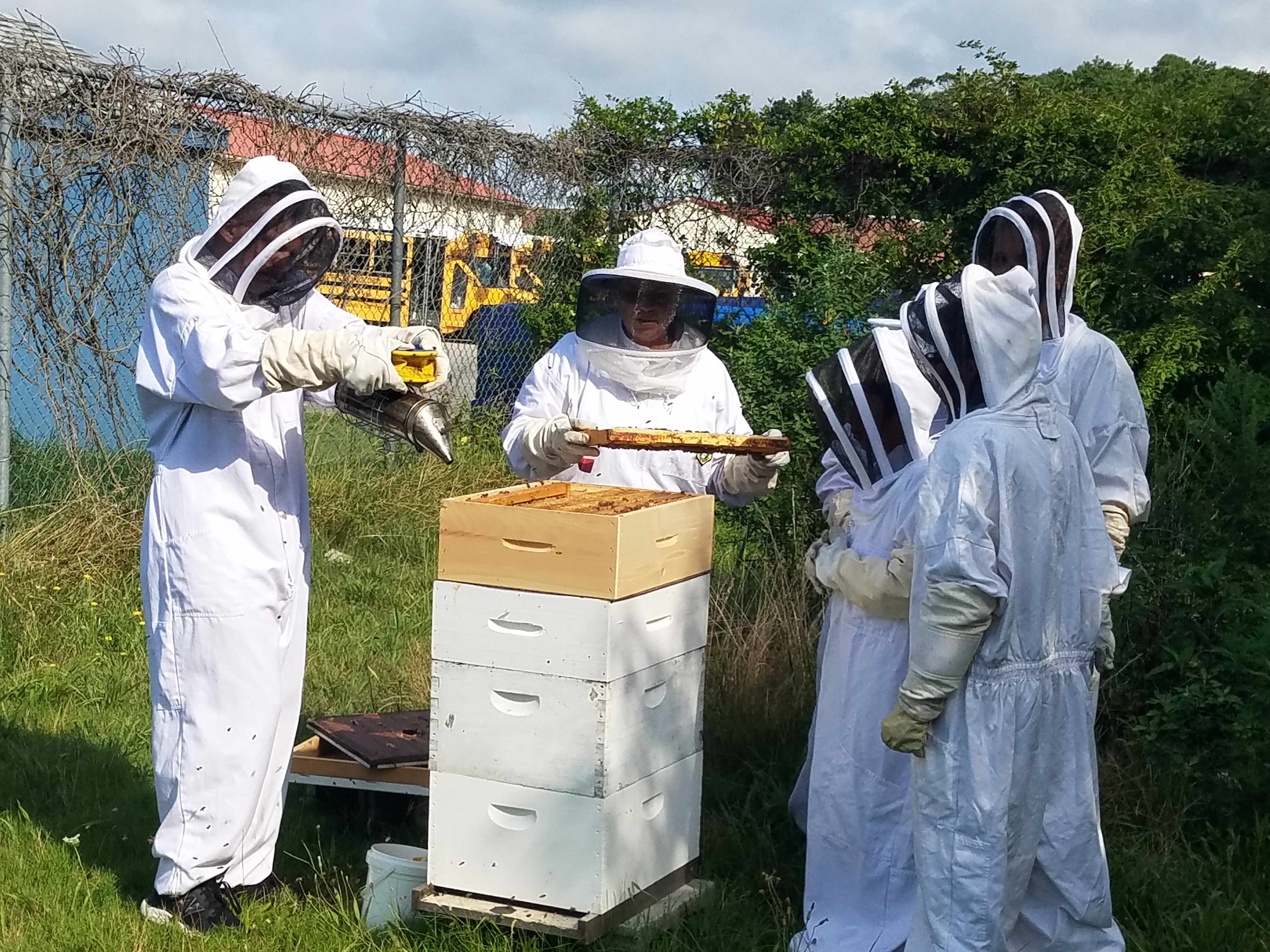ERMA – Students in Lower Cape May Regional High School’s extended summer school program are getting a chance to learn about beekeeping this summer, as they maintain honey bee colonies in four hives in their bee yard.
Donning white protective suits with gloves, hats, and veils, four students and two teachers opened up one of the hives July 18 to take a look at the worker bees, see a honey frame or comb, and identify the queen bee as part of this year’s projects.
The suit is of a smooth, heavy-duty generally light-colored material to provide maximum differentiation from the colony’s natural predators (such as bears and skunks) which tend to be dark-colored and furry.
Before the hives were populated, however, the students had to prepare the apiary or bee yard. “The first week of the summer program we dug out an area for our garden, to plant flowers that would attract butterflies and bees,” noted Karren Barr, one of the high school’s science teachers who is spearheading the summer bee project. “We had researched during the school year the plants that were pollinators that we would need.”
A beekeeper keeps bees in order to collect their honey and other products that the hive produces, including beeswax, propolis, pollen and royal jelly. To make one pound of honey, Barr said a colony of bees collects nectar from a million flowers.
The honey produced by the school is sold at the school store and the money is used to continue funding the program.
In addition, this year the group entered honey and a honey frame in the 4-H Fair competition held July 21 and the honey frame won first place. The honey is judged on its moisture content and taste, while the comb is observed for its uniformity with wax, whether any cells are open, and whether any honey is dripping.
“Our honey was not as tasty as many other entries,” Barr said. “There were a lot of entries in this group and this competition was against many other beekeepers in Cape May County, not schools, sponsored by the New Jersey Cape Beekeepers Association. So our kids did a great job to win anything amongst all of the other beekeepers. We’re very proud of them.”
Pollinators are anything that moves pollen from one plant to another, she explained, such as people, the wind, butterflies, and bees. Pollen is used to make honey and Barr noted that the reason “we need honey bees is because 75 percent of the world’s top 100 crop species rely on honey bee pollination.”
While some plants were purchased, Barr said most were grown in the school’s greenhouse because of their organic nature. “When you buy something from a store, you don’t know what it’s been sprayed with,” she noted. “By using our own greenhouse, we know exactly how they’ve been handled.”
Barr said it’s thought that the collapse of the honey bee colonies is linked to the use of genetically modified organisms (GMOs) used to breed plants. “It’s thought that the bees are affected by the chemicals they use in the GMOs and lose their way back to the hive,” she said. “It’s the reason we wanted to stay organic as much as possible.”
Plants that attract bees and butterflies include those that are blue, white, red, purple and pink. “Their favorite color is blue,” the science teacher said, “so we planted blue salvia, lavender, a butterfly bush, of course, white Shasta daisies, coleopsis, asters and day lilies. You also need to have water in the garden because the bees need water to make honey and wax. We have a small pond with a spray that is solar-powered to keep the water moving. Water lilies are in the pond, as well, because the bees like to land on the flowers.”
Once the garden was planted, the bees and butterflies started arriving. A colony of bees consists of three castes of bee:
* A queen bee, which is normally the only breeding female in the colony;
* A large number of female worker bees, typically 30,000–50,000 in number;
* A number of male drones, ranging from thousands in a strong hive in spring to very few during the cold season.
According to Barr, the queen is the only sexually mature female in the hive and all of the female worker bees and male drones are her offspring. The queen emerges from her cell after 15 days of development and she remains in the hive for three to seven days before venturing out on a mating flight, otherwise known as the “nuptial flight.”
Her first orientation flight may only last a few seconds, just enough to mark the position of the hive. Subsequent mating flights may last from five to 30 minutes, and she may mate with a number of male drones on each flight. Over several matings, possibly a dozen or more, the queen receives and stores enough sperm from a succession of drones to fertilize hundreds of thousands of eggs. A queen could live three to five years.
The queen is raised from a normal worker egg but is fed a larger amount of royal jelly than a normal worker bee, resulting in a radically different growth and metamorphosis, according to Barr. They hatch in 16 days.
The drones’ sole purpose is to mate with the queen. They do not work, do not forage for pollen or nectar, are unable to sting, and have no other known function than to mate with new queens and fertilize them on their mating flights. Barr said they live for about eight weeks, and then leave the hives in the winter to die.
“Honey bees don’t sting unless they think their hive is being attacked,” Barr said.
Most of the bees in a hive are female worker bees. At the height of summer when activity in the hive is frantic and work goes on non-stop, the life of a worker bee may be as short as six weeks; in late autumn, when no brood is being raised and no nectar is being harvested, a young bee may live for 16 weeks, potentially through the winter. Fifty percent of the bees can die over the winter, she added.
Barr said the worker bees collect the nectar from flowers and store it in their honey sacs. “They bring the nectar back to the hive and transfer it to a house worker bee, tongue-to-tongue,” she said. “The house bee will spread the nectar droplets into a honey cell to let it dry. Nectar is very high in moisture (water), about 80 percent, and must dry to become honey, about 19 percent moisture.”
Over the course of their lives, worker bees’ duties are dictated by age. For the first few weeks of their lifespan, Barr said they perform basic chores within the hive: cleaning empty brood cells, removing debris and other housekeeping tasks, making wax for building or repairing the comb, and feeding larvae. Later, they may ventilate the hive or guard the entrance. Older workers leave the hive daily, weather permitting, to forage for nectar, pollen, water, and propolis.
Barr, who has been a beekeeper for nine years, is a member of the New Jersey Beekeepers Association. “I remember when I started, there were eight members,” she said. “Now we are 170 strong.
“Our students are very excited about our honey bee science program,” Barr added. “They understand how important it is to protect our pollinators for our food production and their personal consumption. You know Albert Einstein once said that if the honey bee was to disappear from the Earth, people would only survive for about four years because all our agricultural crops would not survive. This is why I started the Honey Bee Science Program at our school.”
To contact Karen Knight, email kknight@cmcherald.com.






